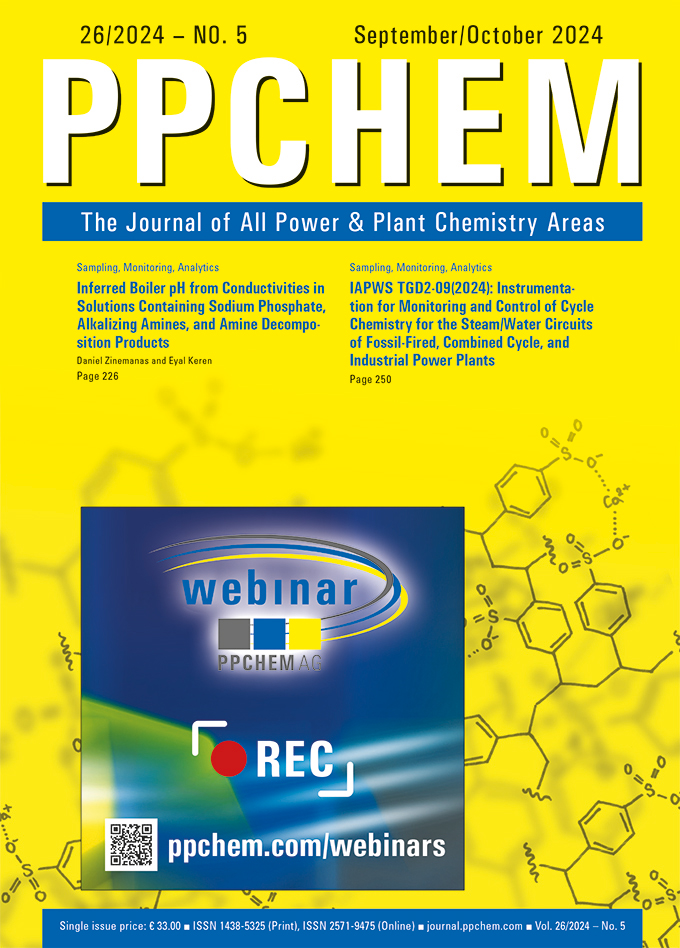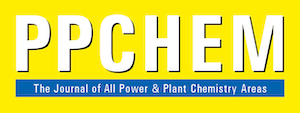
For members only
ABSTRACTS
Tribute to Prof. Wolfgang Wagner
The German-Swiss Association for the Properties of Water and Steam e.V.
This issue includes a tribute to a highly respected member of the International Association for the Properties of Water and Steam (IAPWS) community who recently passed away. Professor Wolfgang Wagner’s dedication, warmth, and significant contributions have left a lasting legacy within our field. He was a pioneer in improving data correlation techniques for the thermodynamic properties of water and steam. Under his leadership, IAPWS developed the current international formulations for the thermodynamic properties of water and steam. His presence will be deeply missed, and we honor him for his invaluable impact on our community. This tribute is from the joint national committee of Germany and Switzerland, of which he was an honorary member.
PPCHEM® 2024, 26(5), 224–225
Inferred Boiler pH from Conductivities in Solutions Containing Sodium Phosphate, Alkalizing Amines, and Amine Decomposition Products
Daniel Zinemanas and Eyal Keren
Accurate knowledge of the pH in boiler water is an important and central chemical parameter for the monitoring and control of the boiler chemical conditions and is critical to minimizing the corrosion processes. pH measurements, however, are not always easily or accurately measured, so alternative means of correctly estimating the boiler pH can be useful for achieving these goals. In certain situations, the conditions are even quite complex and challenging since the impurities which negatively affect the chemical parameters arise from the treatment chemicals themselves, such as, for example, the products of the thermal decomposition of organic alkalizing amines used for pH control. Thus, it is the purpose of the present study to show an alternative way by means of the calculation of the inferred pH from the specific conductivity and the conductivity after cation exchange and to describe its application, together with these conductivities, to the monitoring and control of the boiler water in relatively complex solutions in which sodium phosphates, alkalizing amines, and amine decomposition products are present. The methodology described in the paper is applied in a cogeneration plant with a dual pressure heat recovery steam generator equipped with an air-cooled condenser, where, as demonstrated, very good results were achieved. The study also emphasizes the main concerns and disadvantages regarding the use of organic alkalizing amines in water/steam cycle water treatment.
PPCHEM® 2024, 26(5), 226–237
For Members only
IAPWS TGD2-09(2024): Instrumentation for Monitoring and Control of Cycle Chemistry for the Steam/Water Circuits of Fossil-Fired, Combined Cycle, and Industrial Power Plants
The International Association for the Properties of Water and Steam
This Technical Guidance Document was first issued in 2009 and revised in 2012 and 2015. This 2024 revision includes a small number of updates and clarifications. These do not constitute significant changes to the scope of the document or to the guidance contained.
In order to achieve suitable chemical conditions in steam/water circuits, it is essential to establish reliable monitoring of key parameters on every plant. This enables the demonstration of operation within cycle chemistry targets, and alerts the operators to the need to take corrective action when the target conditions are compromised.
This technical guidance document considers conventional fossil, combined cycle / HRSG, and industrial plants and identifies the key instrumentation and monitoring techniques required for each plant type and cycle chemistry treatment. It is emphasized that this is an IAPWS guidance document and that, depending on local requirements, the use of simpler instrumentation may be adequate, whereas more complex techniques and instrumentation may be necessary when specific issues arise.
PPCHEM® 2024, 26(5), 250–275

